The Samsung Galaxy Note5 and Galaxy S6 edge+ Review
by Joshua Ho on October 2, 2015 8:00 AM ESTBattery Life
Battery life is undoubtedly one of the most important parts of the user experience of any mobile device. One of the major reasons why many people use phablets is to get better battery life, as the PCB size of a phablet is often roughly similar to what you’ll see in a smartphone, but the battery will be bigger to fill the available space. As a result, a phablet has a higher proportion of battery than a smartphone. This inherently means that battery size will scale faster than platform power. In order to test this metric, we use a number of different tests ranging from display-bound web browsing to SoC-bound CPU and GPU load tests. In order to eliminate confounding variables, we test all devices from the same ASUS RT-AC68U router for WiFi testing, and in strong LTE/3G reception for mobile web browsing, in addition to setting all devices to an average of 200 nits on the display.
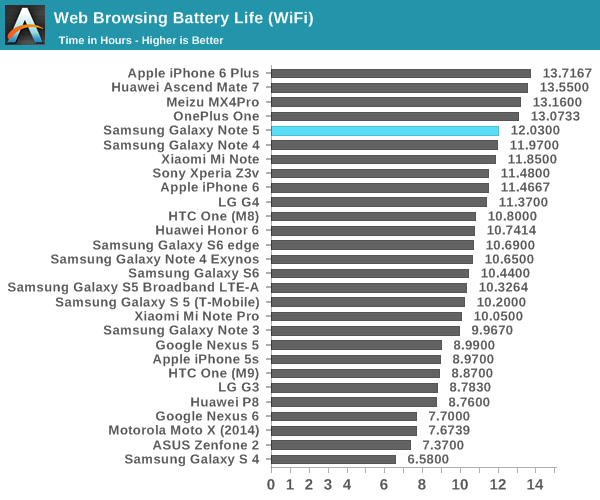
In our first test of WiFi web browsing, the Galaxy Note5 performs identically to the Galaxy Note 4. This might be surprising because the display is the same size and resolution as the Galaxy Note 4 with a smaller battery than the Galaxy Note 4. However, the smaller battery is compensated for due to improvements in SoC and display efficiency. In particular, the move from a planar 28nm process to a 14nm FinFET process dramatically reduces power consumption on the SoC.

In LTE battery life, we see a noticeable drop relative to WiFi battery life. It’s likely that this is mostly due to the power consumption of the Shannon 333 modem present in these devices. There’s not much else to say here, but battery life is still good.
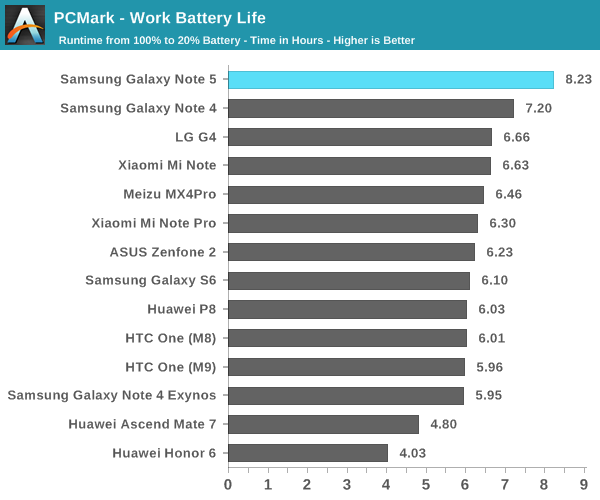
Moving past our mostly display-bound web browsing test, PCMark provides a much more balanced look at battery life as APL tends to vary a bit more with content like videos and photos instead of just webpages, and the CPU component is much more strongly emphasized. Here we can really see the Note5’s Exynos 7420 stretch its legs as it keeps a high performance level with long runtime.
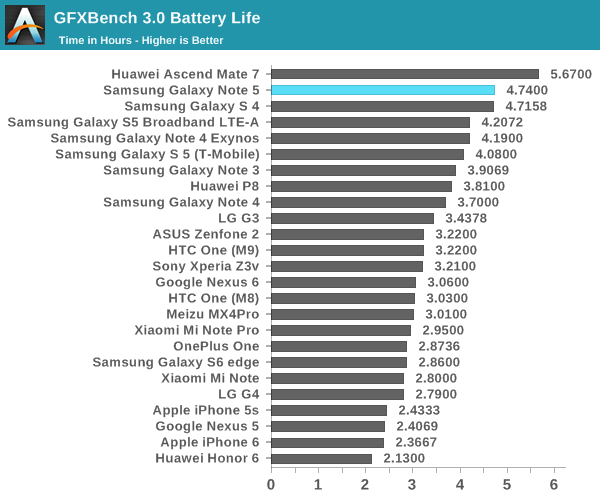
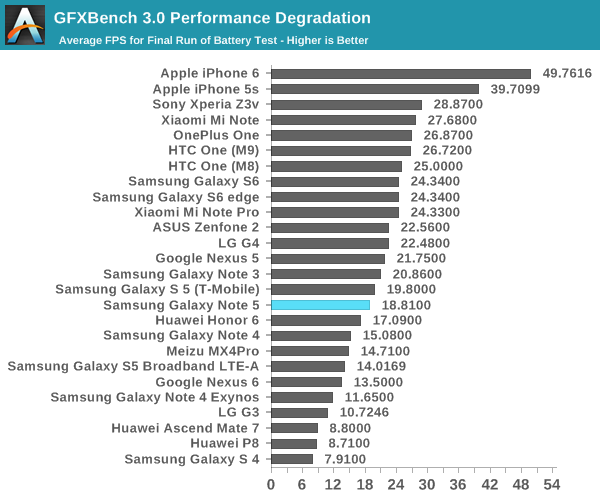
In our sustained SoC-bound workloads, GFXBench shows a healthy improvement over the Galaxy S6. Although we’re unable to test in perfectly controlled temperatures, it looks like Samsung has improved the throttling behavior of the SoC as the throttling appears to be more graceful rather than sinusoidal, and the result is a pretty significant jump in runtime over most devices.
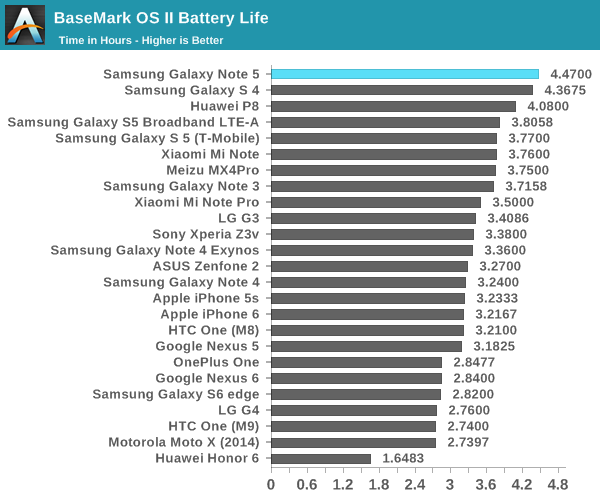

In Basemark OS II, we see a pretty significant uplift in runtime when compared to something like the Galaxy S6 or Note 4. The runtime increase isn’t just due to excessive throttling though, as the battery score shows that this isn’t just a case of throttling the CPU until the runtime is an improvement over past devices.
Overall, if you’ve read the Galaxy S6 review it’s pretty fair to say that you’ll know what to expect from the Galaxy Note5. Battery life is roughly equivalent to the Galaxy Note 4 despite the smaller battery, and due to the greatly improved Exynos 7420 SoC relative to 2014 SoCs SoC-bound cases will show pretty healthy improvements as long as you’re controlling for performance.
Charge Time
While normally battery life is the primary area of concern for a smartphone, in some cases it’s important for a phone to charge quickly. We can all claim to be perfect but one of the simplest cases for faster charging is forgetting to plug the phone in before going to sleep, so the maximum allowable charge time goes from something like 6 hours to an hour at best. As a result, a faster charger can dramatically improve practical battery life in any situation where you have limited time to charge. This can be accomplished by increasing either the current or voltage of the charger. The original quick charging standards improved charge rate through higher current, but this eventually hits a wall due to resistance in the wire. In order to increase the total amount of power delivered without increasing the thickness of the cable used voltage was increased in the case of newer standards like QC 2.0. In the case of the Galaxy Note5 and Galaxy S6 edge+, we’re looking at the same 9V, 1.67A QC 2.0 compatible charger that shipped with the Galaxy Note 4. In order to test this properly, we log the time it takes for the phone to charge by running a timer until the charger power draw hits a point that represents 100% battery.
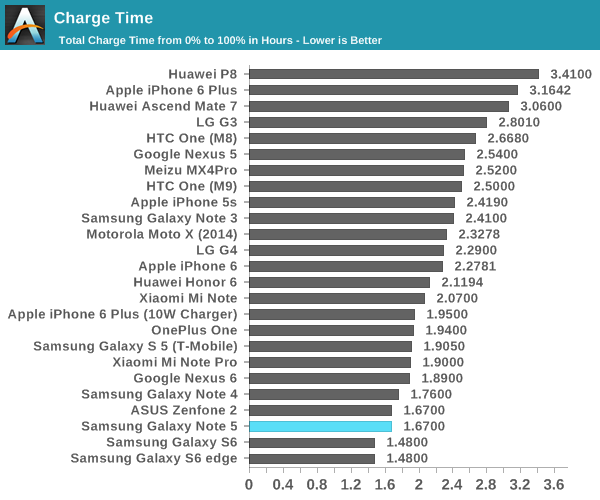
It probably isn’t a surprise, but charge time ends up similar to the Galaxy S6 and Galaxy Note 4. I suspect that we’ll be waiting until QC 3.0 to be able to see significant improvements as the current standard doesn’t have particularly fine-grained voltage scaling according to cable and phone conditions. Interestingly, the wireless fast charger is actually not too far off from the wired charger as it indicates 100% around 1.84 hours into charging which is almost identical to the wired fast charger.


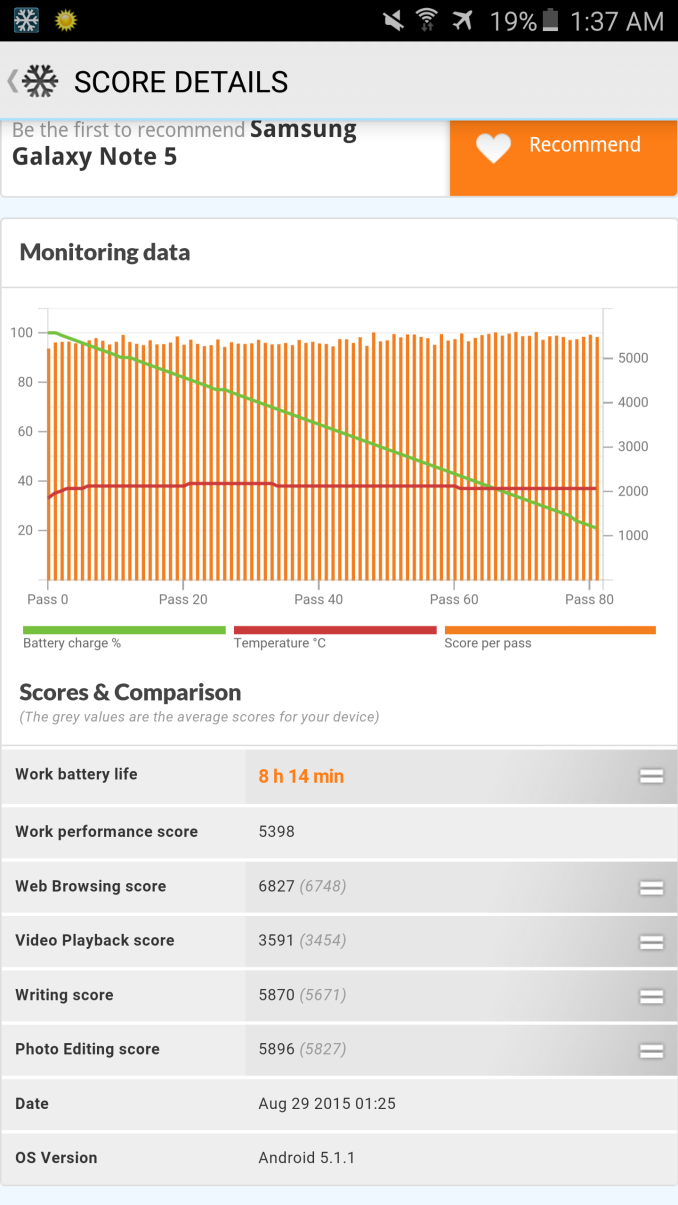
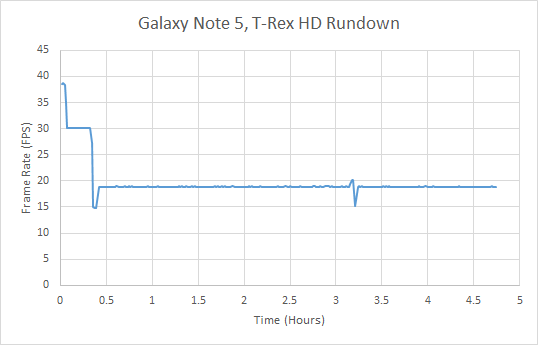
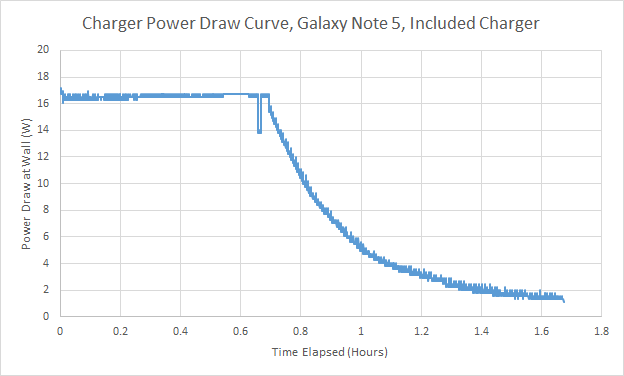
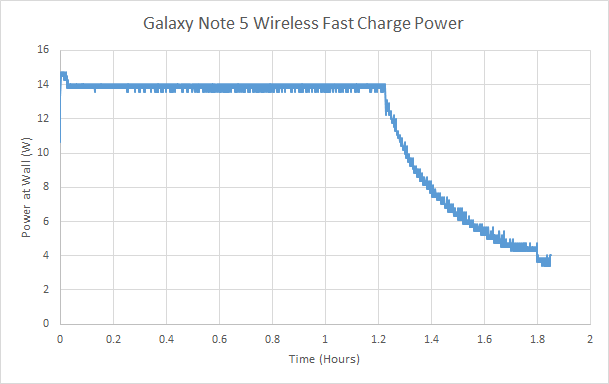








225 Comments
View All Comments
Yanic - Saturday, October 3, 2015 - link
My entire reason for reading this site is because I felt it portrayed an unbiased informative review which is platform agnostic.Kuzi - Saturday, October 3, 2015 - link
I have noticed the same thing for a few years now. Anandtech has been cherry picking benchmarks or omitting when needed to always try to show Apple devices in the best light.In Geekbench multicore exynos 7420 gets 5200, while IPhone 6 gets 2800, and even the iPhone 6S gets only 4400. The story is the same for any other multithreaded tests such as Antutu, 3dmark Physics test etc.
Ryan Smith - Saturday, October 3, 2015 - link
Hi Nerd1,Thanks for the feedback. A couple quick responses to specific items.
Contrast; OLED is infinite contrast since a pure black screen doesn't emit any light. We literally can't even plot it. Which is why we note in the text "Meanwhile the use of OLED means that black levels are perfect and contrast remains solely determined by the lighting of the room and the reflectance of the display"
NAND: There are two factors here. The first is that the NAND has changed relative to the S6. Second, as Josh has commented elsewhere "To add on to this, the main difference is that we're only showing a single IO thread and QD=1 to avoid unnecessarily penalizing eMMC as we found that multiple IO threads is usually an unrealistic workload and that it would negatively affect eMMC performance."
And our benchmarks are based on the metrics we believe are important and are practical to repeatedly and scientifically measure. Truth be told who wins is immaterial, we just want to develop tests that are meaningful while meeting the above goals. And on a related note, this is the same benchmark suite we use in every review, so there is no specific benchmark picking going on.
lilmoe - Sunday, October 4, 2015 - link
You say "scientific", then use browser benchmarks to provide _evidence_ for cross-platform processor superiority... I'm really curious now, Don't you find your statement a bit misleading?Ryan Smith - Sunday, October 4, 2015 - link
It will depend on what we're trying to measure and the what we're trying to investigate. If we want to evaluate the whole phone as a platform, as is the case here, then browser benchmarks are a great tool due to how much use mobile browsers get.Otherwise if we want to measure just SoCs, then we need to be a bit more mindful to account for things like different JS engines. Which is also why we never put too much emphasis on one benchmark, and make sure to run a varied collection.
Though I will add that I'm not sure what this comment is in reference to? The only thing we state with respect to the browser benchmarks on this specific article is "It's probably fair to say that the Exynos 7420 will continue to be the best SoC for Android mobile devices in 2015"
thedons1983 - Sunday, October 18, 2015 - link
Benchmarks prove nothing. And to rely on them so heavily, is just idiotic. Benchmark results, mean absolutely jack sh#t, compared to real life, user experience. If you're not aware of this fact, then why on earth should I listen to a single word that you say?? Benchmarks are for morons, pure and simple.0razor1 - Friday, October 2, 2015 - link
Note 4 aperture size is *incorrect* on page1 :F/2.0 OIS
Should be F/2.2 OIS ?
mercucu1111 - Friday, October 2, 2015 - link
According to GFX 2.7 and 3.0 offscreen. A9 is 40% better than E7420But According to Geekbench
E7420 is 30% better (5600 vs 4400 lol)
So nobody can't say which is better.
ciderrules - Friday, October 2, 2015 - link
Uh, according to Primate Labs the multi score result for the Note5 is 4323. S6 Edge us 4441.Not sure where you're getting 5600 from.
mercucu1111 - Friday, October 2, 2015 - link
It is not overclocked or inflated score.When its 8-core is in full load state. It reachs 1500/5600.